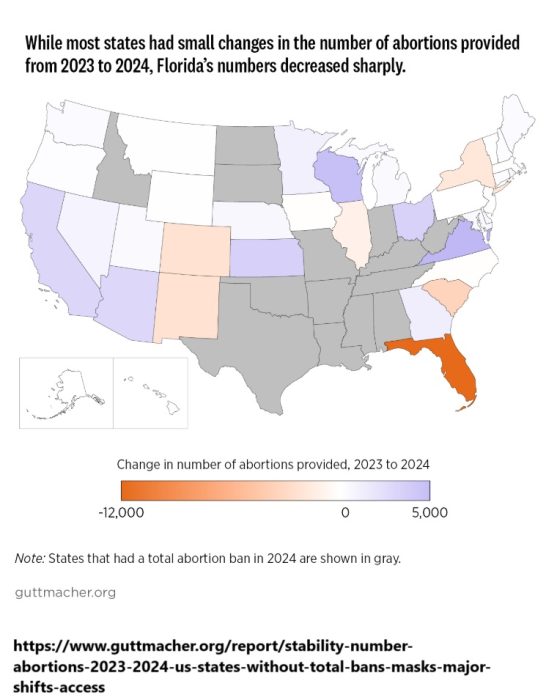The Guttmacher Institute’s Monthly Abortion Provision Study for 2024 shows “1,038,100 clinician-provided abortions in states without total abortion bans in 2024, an increase of less than 1% from 2023.” Planned Parenthood’s former “special affiliate” and research arm claimed that “[t]he overall stability in the number of abortions in states without total bans continued despite shifts in policy that have increased obstacles to accessing this care in many states.”
Does this mean that the increase in abortion numbers is beginning to stabilize since the end of Roe v. Wade? Maybe — but maybe not. As Guttmacher notes, its new figures are an underestimate.
Key Takeaways:
- Guttmacher’s new 2024 figures are an underestimate, as it did not track data in states with ‘total bans’ on abortion.
- Guttmacher’s yearly abortion figure for 2024 is 1,038,100 “clinician-provided” abortions. This doesn’t include all abortions.
- This new 2024 figure equates to 2,844 abortions daily, nearly 119 per hour, nearly two per minute, and slightly more than one every 30 seconds.
- Guttmacher has reported over 64 million preborn human lives lost to abortion in the U.S. since 1973.
- ‘Telehealth’ abortion increased in 2024, though most abortions still took place in brick-and-mortar facilities.
- Travel from pro-life to pro-abortion states continued in 2024, though the proportion traveling decreased.
- Prior to the reversal of Roe v. Wade, Guttmacher used a more reliable method of data collection every few years. Since that time, it has chosen to release less reliable monthly “estimates.”
“Our estimates exclude any abortions provided in states with total bans (through shield law provision, community health networks, online pharmacies or other means),” Guttmacher wrote, “and therefore represent an underestimate of the total number of abortions nationally” (emphasis added).
Since 1973, Guttmacher has reported over 64 million preborn lives lost to abortion, and that number is likely larger, given the exclusions.

Guttmacher Institute 2024 abortion numbers
Guttmacher footnoted, “Throughout most of 2024, 14 states had total bans on abortion in effect. North Dakota’s total ban was repealed on September 26, 2024 (although the state remains without any abortion providers) and Missouri’s total ban was blocked on December 20, bringing the number with an explicit total ban down to 12” (emphasis added).
Guttmacher’s newly-updated figure reveals that in 2024, at least 2,844 abortions were committed daily in the U.S. — nearly 119 abortions per hour, nearly two per minute, and slightly more than one abortion committed every 30 seconds.
Beginning in 2017, the United States saw the end of a long-term decline in the number of abortions, with numbers beginning to tick upwards year after year. By 2020, abortions totaled 930,160 — an increase of nearly 8% from 2017. Then, in May of 2024, the Guttmacher Institute updated its total abortion estimate for 2023, revealing that 1,037,000 abortions were recorded by the formal health care system that year (which does not include chemical abortions obtained from online pharmacies, etc.) This time, the increase over three years was in the double digits, revealing a spike of 11.5% from 2020.

Reported abortions 1973 to 2024 source Guttmacher Institute CDC 1973-2022
Sharp decreases in specific states
According to Guttmacher, “Florida experienced a particularly sharp decline in the number of abortions provided after a six-week ban went into effect in May 2024: Over the full calendar year, there were 12,100 fewer abortions provided in the state in 2024 than in 2023.”
In 2023, Florida reported a total of 84,052 abortions but that dropped to 64,854 reported for 2024 (Florida’s six-week protections were instituted in May of that year.) So far in 2025, Florida has reported 8,682 abortions.

Guttmacher Institute Florida had large decrease of abortions 2023-2024
In addition, Guttmacher noted that”South Carolina’s six-week ban went into effect in September 2023; as a result, the state had the second-largest decline (after Florida), with 3,500 fewer abortions provided in the state in 2024 than in 2023.”
Even pro-abortion states reportedly saw some declines after the end of Roe. Guttmacher noted that “Colorado and New Mexico declined by around 2,400 cases each between 2023 and 2024, but total counts in these states remained substantially higher in 2024 than their baselines before Roe v. Wade was overturned in 2022.”
These decreases may not last. New Mexico’s governor began funneling millions into building a new state-funded abortion facility in 2022 (which opened near the end of 2024), and this year added another $10 million to the state budget to construct a second abortion facility with taxpayer dollars. And Colorado just passed a bill forcing taxpayers to fund abortions in the state.
Guttmacher suggested that “The decreases in [Colorado and New Mexico] may be happening in part because of increases in clinic capacity in Kansas, which had an increase in abortions provided from 2023 to 2024.”
Other states saw increases. “Clinician-provided abortion care was largely unavailable in Wisconsin following the overturning of Roe until the latter half of 2023; as a result, the state had a large increase from 1,300 abortions provided in 2023 to 6,100 in 2024 (an increase of 388%) as access expanded.”
Additional states — including some with expansions under ballot initiatives — also saw increases. According to the report, “Arizona, California, Kansas, Ohio, and Virginia had substantial increases in the number of abortions provided (ranging from an increase of 3,000 in Arizona to 5,500 in Virginia),” with Guttmacher adding that Virginia likely “absorbed patients affected by Florida’s six-week abortion ban after it went into effect in May 2024.”
Kansas reportedly saw an increase of 3,300 abortions for out-of-state patients, while Virginia saw an increase of 4,300. “This increase in travel from other states was the main driver of increased abortion counts overall in both states,” wrote Guttmacher, “although other factors like expanded clinic capacity also may have increased access for state residents.”
Abortion pill data and online abortion increases
Guttmacher noted how ‘telehealth’ abortion is increasing, writing, “The share of abortions in states without total bans that were provided via online-only clinics rose to 14% in 2024 from 10% in 2023 (an increase of around 40,000 abortions),” adding that the national abortion share for “online-only clinics” is “almost certainly higher than this, as the 14% proportion does not include shield law provision into states with total abortion bans.” Guttmacher noted that “Recent estimates from the #WeCount study document that 34,500 medication abortions were provided via shield laws to states with total bans in the first half of 2024.”
Despite this increase, Guttmacher noted that most abortions in 2024 still took place in brick-and-mortar abortion businesses, as “[t]elehealth provision is not an available or preferred option for everyone seeking an abortion.”
Abortion pill data for 2024 has not been published; however, Guttmacher estimated that the abortion pill accounted for 63% of abortions in 2023 — a 45% increase from 2017. In February of 2025, Guttmacher reported the distribution of 648,500 abortion pills in 2023 (54,042 monthly, 1,777 daily, 74 hourly, and one abortion by pill every 49 seconds).
“The number of medication abortions provided in US states without total abortion bans increased by 19% between 2019 and 2020, and by 32% between 2020 and 2023,” Guttmacher wrote.
The Monthly Abortion Provision Study previously reiterated that its abortion pill counts don’t include those that “take place outside of the formal health care system” or those “mailed to people in states with total abortion bans.”
How Guttmacher gathers data
Since the Dobbs decision in 2022, two agencies have attempted to publish estimated abortion data: the Guttmacher Institute and the Society of Family Planning (SFP) — or #WeCount, the latter of which was founded in 2005 with a contribution from the Packard Foundation. SFP is heavily funded by the Buffett Foundation. Now, instead of reporting updated data every few years or so as it did prior to Dobbs, Guttmacher has chosen to publish monthly abortion estimates on a regular basis.
Nationally, the Centers for Disease Control and Prevention (CDC) also publishes data, but it is generally not seen as comprehensive as what Guttmacher provides. The CDC utilizes data provided by states while Guttmacher surveys abortion providers. Many states do not require reporting of any kind on abortion.
As previously noted, the monthly Guttmacher study “estimates the number of clinician-provided abortions that take place each month in each US state without a total ban,” but excludes “any abortions provided in states with total bans” as well as those obtained through online pharmacies or other means.
But this isn’t the same methodology that Guttmacher used before the end of Roe v. Wade.
In past reports, Guttmacher relied on the “Institute’s Abortion Provider Census (APC), fielded every three years since 1974″ described as “the most comprehensive data collection effort on abortion provision in the United States.” Guttmacher claimed that “Each census is a sustained effort requiring a long fielding period, significant follow-up and substantial time and effort from abortion providers themselves.”
Then, in late 2023, after nearly 50 years of using the same methodology, Guttmacher changed and began publishing monthly abortion estimates, which it openly suggested is less reliable than what it previously used. “The Monthly Abortion Provision Study… produc[es] a slimmer portfolio of data but at a much quicker pace. Its design is responsive to the needs of policymakers, advocates and other stakeholders in the fast-changing landscape of US abortion policy and provision and attempts to minimize the time required of staff at surveyed facilities” (emphases added) Guttmacher wrote.

Monthly Abortion Reporting Guttmacher “Slimmer portfolio” methodology
Abortion travel continued, with a slight decrease
Guttmacher claimed that in 2024, there was a decline in people traveling to “states without total bans” to access abortion, writing that “the proportion of people traveling across state lines to obtain an abortion declined slightly, from 16% to 15%,” which is “approximately 155,100 people” compared to the 169,700 who traveled across state lines in 2023. Yet, “it is still close to double the number who did so before the end of Roe (81,100 in 2020).”
The states with the highest number of abortions provided to out-of-state residents in 2024 were reportedly the same four as in 2023:
- Illinois: 35,000 abortions, representing 39% of all abortions provided in the state
- North Carolina: 16,700 abortions (36% of abortions in the state)
- Kansas: 16,100 abortions (71% of abortions in the state)
- New Mexico: 12,800 abortions (69% of abortions in the state)
“Out-of-state residents represented the majority of abortions provided in New Mexico in 2024 (69%), and slightly over one-quarter (26%) of abortions provided in Colorado. Both states, however, experienced declines in the overall number of abortions provided between 2023 and 2024, driven largely by declines in travel from out of state: New Mexico provided 1,900 fewer abortions to out-of-state residents in 2024, and Colorado provided 1,200 fewer,” wrote the pro-abortion group.








